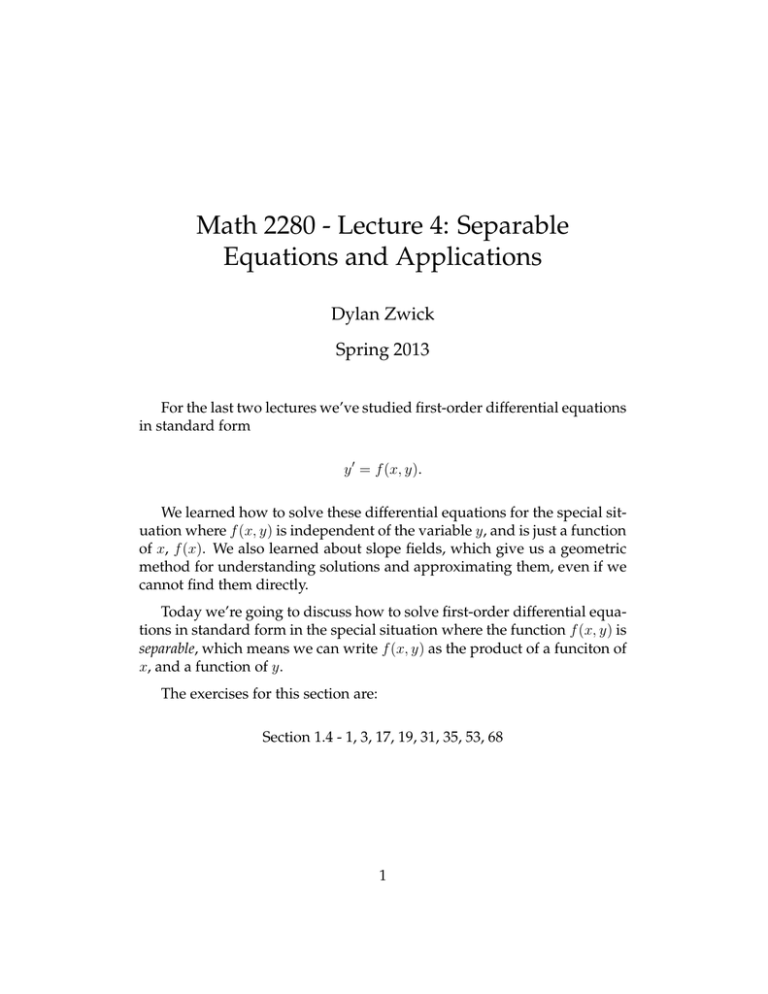Math 2280 - Lecture 4: Separable Equations and Applications Dylan Zwick Spring 2013
advertisement

Math 2280 - Lecture 4: Separable Equations and Applications Dylan Zwick Spring 2013 For the last two lectures we’ve studied first-order differential equations in standard form y ′ = f (x, y). We learned how to solve these differential equations for the special situation where f (x, y) is independent of the variable y, and is just a function of x, f (x). We also learned about slope fields, which give us a geometric method for understanding solutions and approximating them, even if we cannot find them directly. Today we’re going to discuss how to solve first-order differential equations in standard form in the special situation where the function f (x, y) is separable, which means we can write f (x, y) as the product of a funciton of x, and a function of y. The exercises for this section are: Section 1.4 - 1, 3, 17, 19, 31, 35, 53, 68 1 Separable Equations and How to Solve Them Suppose we have a first-order differential equation in standard form: dy = h(x, y). dx If the function h(x, y) is separable we can write it as the product of two functions, one a function of x, and the other a function of y. So, h(x, y) = g(x) . f (y) In this situation we can manipulate our differtial equation to put everything with a y term on one side, and everything with an x term on the other: f (y)dy = f (x)dx. From here we can just integrate both sides of the equation, and then solve for y as a funciton of x! So, for example, suppose we’re given the differential equation dP = P 2. dt We can rewrite this equation as dP = dt, P2 and then integrate both sides of the equation to get − 1 = t + C. P 2 Solving this for P as a function of t gives us P (t) = 1 1 . C−t Note that this function has a vertical asymptote as t approaches C. If this is a population model, this is called doomsday! Examples of Separable Differential Equations Suppose we’re given the differential equation dy 4 − 2x = 2 . dx 3y − 5 This differential equation is separable, and we can rewrite it as (3y 2 − 5)dy = (4 − 2x)dx. If we integrate both sides of this differential equation Z 2 (3y − 5)dy = Z (4 − 2x)dx we get y 3 − 5y = 4x − x2 + C. This is a solution to our differential equation, but we cannot readily solve this equation for y in terms of x. So, our solution to this differential equation must be implicit. 1 Note that we’re playing a little fast and loose with the unknown constant C here. In particular, if we multiply an unknown constant C by −1, it’s still just an unknown constant, and we continue to call it (positive) C. 3 If we’re given an initial value, say y (1) for the unknown constant C: = 3, then we can easily solve 33_5(3) =4(1)— 1 +C=C=9. 2 So, around the point (1, 3) the differential equation will have the unique solution given implicitly by the curve defined by — 2 = — + • Example Find all solutions to the differential equation - dy dx (y-i) 3 4 (y-i)’ 6x(y-1) C I y (/) 2 7. I i t 150 c If ee e,i v/ ptbJei :? ‘,f’/ z o/i4j; y; (x) /?/7 4 07) o 0 —4-- >c fl qJ 0 L S - 0 -_s (J ¶ s cD Lfl A very common, and simple, type of differential equation that is used to model many, many things2 is dx = kx dt where k is some constant. Now, this is a separable equation, and so it can be solved by our methods. First, we rewrite it as dx = kdt, x and then integrate both sides Z dx = x Z kdt to get ln x = kt + C. If we then exponentiate both sides we get x(t) = ekt+C = eC ekt = Cekt .3 So, the solution to our differential equation is exponential growth (if k > 0) or exponential decay (if k < 0). If k = 0 the answer is just a boring unknown constant. 2 Compound interest, population growth, radioactive decay, etc... The American Society for the Prevention of Notation Abuse would strongly protest this last equality. I’m just saying that eC , where C is an unknown constant, is itself just an unknown constant, and I don’t like having to come up with new letters, so I just continue to represent the unknown constant as C. 3 6 Radioactive decay is quite accurately measured by an exponential de —0.0001216 if t is C decay, the decay constant is k 4 cay function. For ‘ measured in years. Example Carbon taken from a purported relic of the time of Christ con tained 4.6 x 1010 atoms of 140 per gram. Carbon extracted from a presentC per 1 day specimen of the same substance contained 5.0 x 1010 atoms of ‘ gram. Compute the approximate age of the relic. What is your opinion as to its authenticity? - () (C (()= -xfo Co — Qc)1l/ / 0 io) 1 q - 5) pI qyd_) 7



